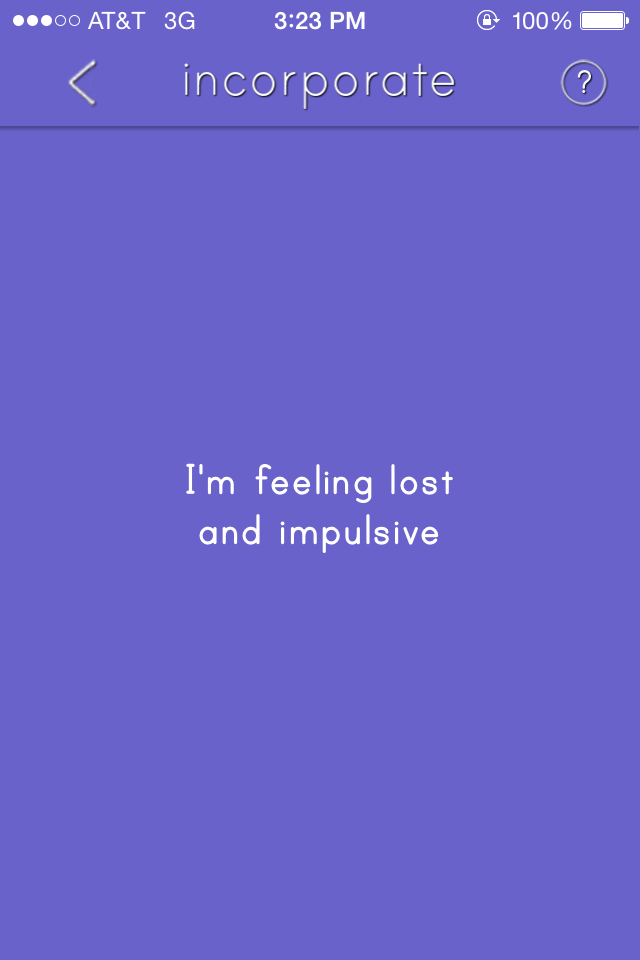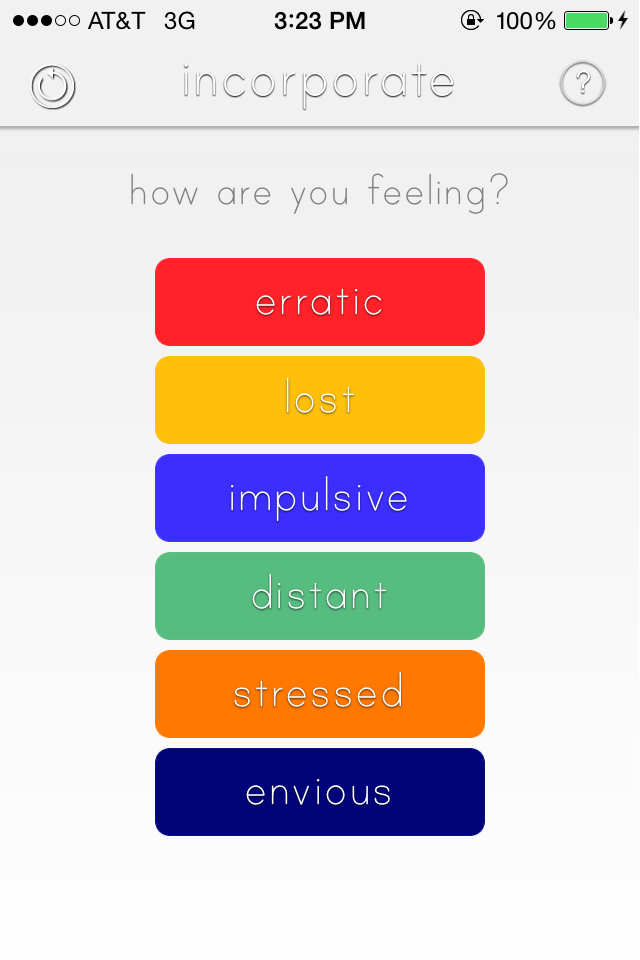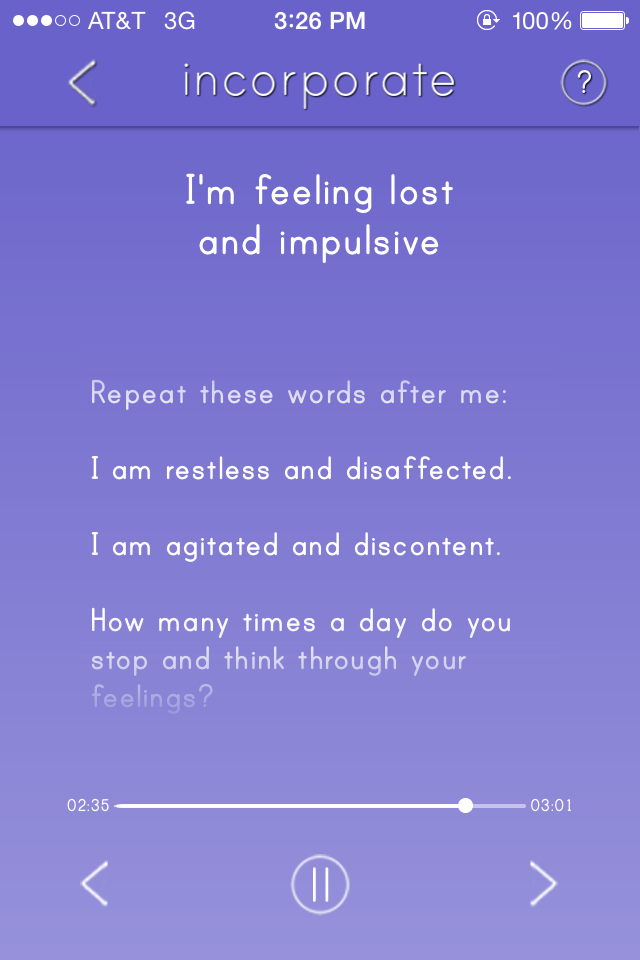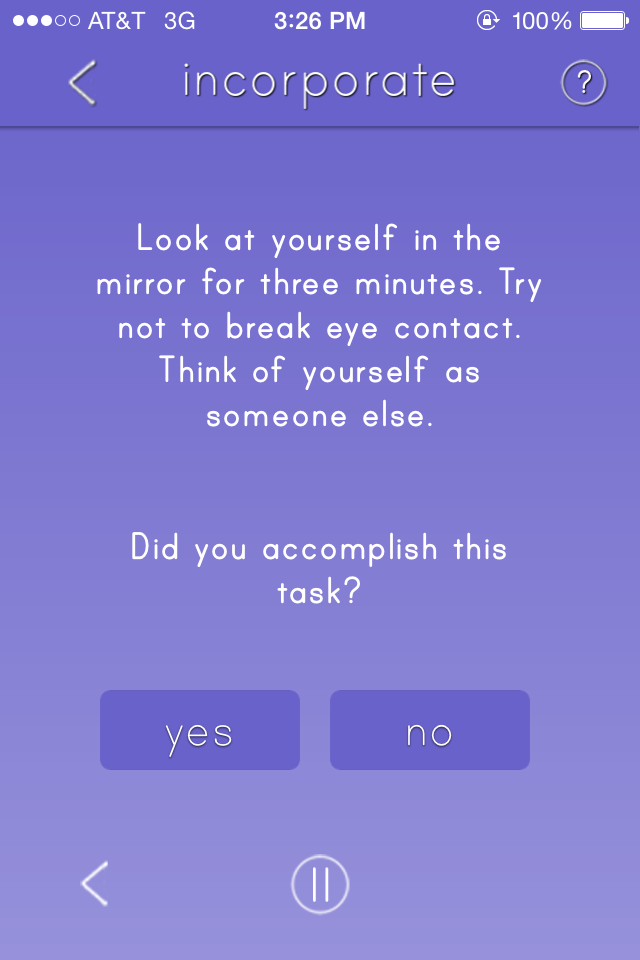Incorporate introduces itself in the iOS app store with a simple inquiry: "How do you connect to others, if you're not connected to yourself? This experiment in digital relaxation comes from artist duo Essex Olivares by way of support from SculptureCenter. It is an artwork designed to circulate among apps, taking its place in—and perhaps commenting on—an increasingly crowded landscape of self-help tools for the informationally overloaded.
The opening screen asks, "how are you feeling?" above a menu of rounded buttons displaying six succinct emotions: overwhelmed, torn, centered, hostile. Select one or two.

I choose two emotions—blocked and flustered. The screen transitions to the first exercise. A transcript of the upcoming verse appears onscreen; below it, a progress bar, a pause button, and navigation arrows. The minimal interface tempts me to interact. An even-toned voice, speaking softly alongside an original soundtrack of chimes, saxophone, and plenty of synth, asks me to focus on my breathing, a rudimentary relaxation technique:
Breathe in through you nose and out through your mouth.
Feel these words through your body.
With every breath, you release more tension.
I breathe. I try to release tension. "With every breath, you release more tension." It recites, but with every breath, I realize I am not really focusing on my breath. Tension levels remain the same even though I visualize tension melting away. "With every breath..." Without realizing it, I'm scrolling through the transcript. I'm disappointed to find these are the only words. With every breath, my mind wanders back to the usual places. I click "Next." It's not Incorporate's fault; it's mine. My brain isn't accustom to this brand of touch-screen surrender.
The pavlovian response to a touchscreen is counter-productive to real relaxation, meditation, or introspection. My mind has learned to switch on with the device. While I'm trying to relax with this app, millions of neurons are prepared to receive a cascade of information. I can't feel at ease with an iPad glowing back at me.
I try closing my eyes. Sans screen, I'm able to appreciate the audio environment Incorporate creates. It's clear that the audio and text alone is the app's strongest facet, well written and at times poignant. The music is soothing without relying on new age staples of whale sounds or ocean waves accompanied by wind instruments.
However, the interface is rife with elements borrowed from other places of daily, thoughtless interaction: the transcript on the screen, the pause button, the next arrow, the yes or no questions. If the exercise's design worked as well as the content, using visuals and interaction to enhance and facilitate the concepts (like a non-sexual Luxuria Superbia), Incorporate just might be able to détourne my well-trained neural pathways and create a hypnotic and deeply relaxing experience. Instead, the design is almost wilfully mundane, anti-transcendent.
Is the app an exercise in futility, a comment on the impossibility of app-based meditation? Is it badly designed? Or, does it just want me to close my eyes? If the audio track were to play for a full hour, I can see myself being lulled away from my usual hyperactive thought process and into relaxation. But that's not the case. Soon, the verse ends and a truncated version of this exercise's soundtrack plays on loop. The loop is not seamless and not as pleasant as the exercise itself. I'm forced to interrupt the feeble beginnings of release and open my eyes. The task following each audio visualization waits to be tended to:
Throw away your phone.
Did you accomplish the task?
Two buttons appear below yes and no. Answering "No" returns me to the previous exercise.
Throw away your phone.
I'm on an iPad. My phone rests peacefully in my bag. This hardly marks a departure from my routine: I visualize throwing my phone away daily, hourly, whenever I'm lost in a feed. Other tasks use heavy-handed symbolism and are equally ineffective. "You are a cactus. Remove every single one of your spines." "You are a block of ice, slowly melting into the person next to you." I glance at the stranger beside me on the train. We make eye contact and she shifts her body away from me, uncomfortable. "Did you accomplish the task?" Yeah, sure. The screen eases into the next verse, not once questioning the integrity of my answer, even when I have clearly not followed instructions, my intact phone by my side.
I try different variations by refreshing and recombining the emotions. There are more repetitive verses that my mind wanders away from. Other exercises read as 3-minute psychotherapy, asking about childhood embarrassment or digging at the possible roots of contemporary disillusionment. "Right now, on this device through which you are listening to me speak, you are being tracked, recorded, and monitored," I'm told, as though I'm not already aware. Like most cold readings, Incorporate relies on overgeneralization. For every line that applies to me, there is one that does not.
Completing three exercises leads to a congratulatory closing screen:
You've reached the end of this process.
You've dug deep inside yourself. Drawn your own conclusions. You're ready to incorporate into the world.
There is only one button: "I'm ready." If you say so. I tap it. The app doesn't shut off or call me a liar. I don't incorporate into the world. I'm back at the menu, ready to spend more time in the service of a bot. "How are you feeling?" My starting emotions remain selected. Accurate, as I feel exactly the same as when I began.
The Incorporate app was developed for the exhibition "Chance Motives." (2014) at SculptureCenter, curated by Kari Rittenbach, and supported by SculptureCenter's In Practice program.




